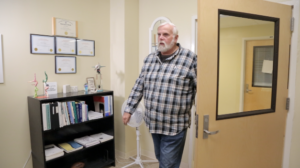Recovery Tree helps RI families Find Solace Amid Opioid Epidemic

David Dorsey is a familiar face in the RIDOC MAT program because he has served as one of its key administrators since it started in 2016. His role in the program has undoubtedly saved hundreds of lives, but he has also used his spare time to help inmates heal from the stigma of addiction through his “Recovery Tree.”
On a fall afternoon, David Dorsey patiently waited in the Bernadette Building located at the Cranston prison complex. His office is housed within the halls of a former penitentiary that used to hold female prisoners, but it was repurposed years ago for administrative use, according to Dorsey.
Dorsey, who helps run the Rhode Island Department of Corrections’ MAT program, has been with CODAC Behavioral Healthcare since 2016 and formerly worked at another treatment center for more than a decade. His experience in the recovery field has allowed him to gain plenty of other institutional knowledge that would be difficult to find in books.
Involved in the MAT program since its earliest days, Dorsey explained the nuances of the program and cited statistics to show how the program has addressed the opioid epidemic in Rhode Island.
“We have a lot of people looking at us to copy what we are doing here. The last article I read, we were able to reduce the recidivism of people leaving our system. . .essentially, we’ve helped reduce the overdose death rate by 61 percent,” Dorsey said. “That’s a hell of a number in my opinion.”
The MAT program at the Adult Correctional Institution was implemented at the suggestion of healthcare counselors and Brown University researchers who advised Gov. Gina Raimondo’s Overdose Prevention and Intervention Task Force. The group agreed that one way to reduce overdoses at the height of the crisis meant reaching out to patients earlier in their recovery process. Since many patients with an addiction have been involved in the criminal justice system for incidents related to their opioid use, it was logical to incorporate a program in the state’s correctional facilities, according to Linda Hurley, President/CEO of CODAC.
Inmates are screened for substance use disorders when they are admitted into one of Rhode Island’s correctional facilities, and are enrolled into medication assisted treatment if they are dependent on a substance.
Dorsey is involved in the case of every person who is receiving medication at the ACIs, and he is especially proud to be making a difference in his community. His passion for helping the recovery community comes from his own battles with addiction, and losses he has felt first-hand.

“We have a lot of people looking at us to copy what we are doing here. The last article I read, we were able to reduce the recidivism of people leaving our system. . .essentially, we’ve helped reduce the overdose death rate by 61 percent,” Dorsey said.
One way Dorsey has helped patients heal outside of the prison walls is an art installation he created that is titled the ‘Recovery Tree.’ During a meeting with a handful of people that included Rebecca Boss, the current director of the R.I. Department of Behavioral, Healthcare, Developmental Disability and Hospitals, the group was strategizing about community centric elements they could incorporate into the Rally4Recovery events they were planning to introduce to local communities.
Dorsey and others became enamored with the idea of a “Recovery Tree” that would connect those in recovery with outside observers. The idea was simple. Inmates and others in recovery would write their name and sobriety date on paper cutouts that resemble leaves. And people seeing the installation for the first-time would see the symbolism behind a tree composed of broken branches and leaves that had found a new purpose.
“The idea was that they could bring the tree back to life because recovery does work. Recovery does improve lives. It does heal. It does bring families back. It reunites children with their parents who are addicted,” Dorsey said.
A recent story that invoked strong emotions from Dorsey involved an inmate who reconnected with a loved one through his “Recovery Tree” at this year’s Rally4Recovery in Providence. Dorsey was preparing to bring his “Recovery Tree” when he remembered that he had collected leaves from inmates at the Medium Service Center. He promptly attached those leaves at the start of this year’s rally.
“Halfway through this rally, this woman came up to me and she was so happy,” Dorsey said. “It just made her so happy that she could find her partner’s name and they were able to put their leaves side by side.”
“It was nice to see my tree was doing good,” Dorsey added.
In the beginning years of the rallies, he explained that organizers tried to raise money to help keep the annual event going. And that is still largely happening through sponsorships, but it has never prevented him from creating the tree.
“The money piece never mattered to me. I still made the tree,” Dorsey said. His motivation, he says, comes from being in recovery for 27 years.
Dorsey has also lost someone like the hundreds of families that have lost a loved one amid the crisis. News of his step son’s passing came as a shock to him and his family because they believed he was in recovery. Many people avoid seeking help because of the stigma associated with addiction, an issue that Rally4Recovery advocates say is being tackled head-on every year.
“In these last couple of years since my step son died, they dedicated the tree to him and his memory,” Dorsey said while holding back tears. “It’s always been personal, but now it’s really personal.”
Dorsey plans to install the tree again next year.



Recent Comments